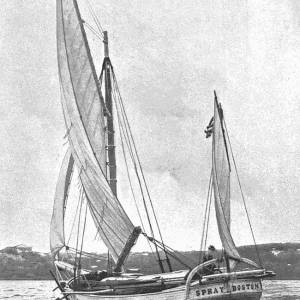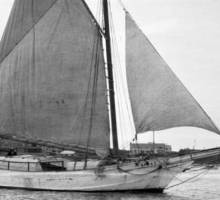
Astonishing Small Boat Voyages: The First Single Handed Circumnavigation of the Globe - Part 1.
Have you ever wondered why so many sailing yachts are named Joshua or Spray? It’s in honour of Joshua Slocum who completed the first single handed circumnavigation between 1895 and 1898. Those were the days before air travel or wireless communication so it is not surprising that the first single handed circumnavigation is often attributed to Sir Francis Chichester who achieved the same feat in the full glare of global media attention 75 years later. Slocum recounted his voyage in his book “Sailing Around The World”. It’s a wonderful read for the adventurous.
Slocum was a seasoned mariner and boat builder. The Spray was an abandoned oyster-catcher boat that was gifted to him. He re-built her from the keel up at Fairhaven, Massachusetts. The experience of the re-build was to prove invaluable as it gave him intimate knowledge of the boat and the ability to tackle virtually any maintenance issue.
From Fairhaven he departed for Boston from where he left on his voyage on the 25th April 1895. It would seem that his crossing to the Azores was relatively uneventful arriving there virtually exactly 18 days after his departure from Boston. The generosity of the Azoreans was to almost result in a premature end of his adventure.
On the 24th July he departed from Horta on the island of Fayal with Gibraltar as the next destination. The plums and Pico white cheese gifted to him on the islands poisoned him. For days he lay delirious and in pain within the cabin as the Spray sailed on with “the pilot of the Pinta” at the helm. The Pinta was one of Columbus’s ships and Slocum seemed convinced that the ghost of its pilot had sailed the Spray thorough the gales for him until he recovered a few days later.
The Spray’s stay at Gibraltar seems to have been a merry round of entertainment and partying courtesy of colonial and naval personalities. His stay there was so enjoyable that in his book he says: “ That one should like Gibraltar would go without saying. How could one help loving so hospitable a place?” Slocum had intended to sail through the Mediterranean and east via the Suez Canal however naval reports of pirates in the Red Sea persuaded him to change his plans.
On the 25th August he departed Gibraltar destined for Brazil. He was fortunate to find the strong Levanter (easterly) wind to take him out of the Strait as he reports having been chased by Barbary Pirates in a felucca. His track took him past the Canary Islands and the Cape Verde Islands. He was now well into his second Atlantic crossing in less than six months. He seems to have enjoyed his solitude because not once does he complain about being alone. After 40 days at sea he pitched up at Pernambuco in Brasil on the 5th October. Brazil was a country he had visited previously and after being feted by an old friend he once again re-provisioned and set sail south for the Horn on the 23rd Oct. In fact he touched base at Rio de Janeiro, Montevideo and Buenos Aires but, as he had predicted, his biggest challenge was to be the Horn.
Slocum’s challenge in the south was twofold: wind and dangerous natives. On the 11th Feb 1896 the Spray entered the Straits of Magellan at Cape of Virgins. The heading westerlies and unpredictable Williwaws in the straits together with the constant danger of being overwhelmed by Fuegian Indians was a constant drain on Slocum. He did not emerge into the Pacific until the first week of April. During all this time he keep his rifle and revolver to hand and indeed he used his rifle to ward off approaching Fuegians led by Black Pedro a fugitive murderer wanted by the Chilean authorities.
In his account of the voyage Slocum is visibly relieved to finally emerge into the Pacific and head for Juan Fernandez Island arriving there on the 26th April. As background Juan Fernandez was the island on which Alexander Selkirk was castaway for four years when he was eventually rescued, by which time he had become adept at hunting and making use of the resources that he found on the island. Selkirk’s story of survival was widely publicised after his return to England, becoming a source of inspiration for writer Daniel Defoe’s character Robinson Crusoe.
To be continued next month when Slocum meets the widow of famous author Robert Louis Stevenson Samoa and African explorer Mr. Stanley at Cape Town.


